

A Product Manager’s Job. Product management is one of the hardest jobs to define in any organization, partially because it’s different in every company.
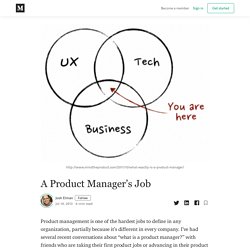
I’ve had several recent conversations about “what is a product manager?” With friends who are taking their first product jobs or advancing in their product careers. I wanted to capture and share them here. Please share your feedback via notes. Good Product Manager / bad product manager by Ben Horowitz. Product Hunt Blog — What Makes a Great Product Manager? 10 Product... A Product Manager’s Musings. A Product Manager’s Musings A Product Manager is a strange occupation in Silicon Valley.
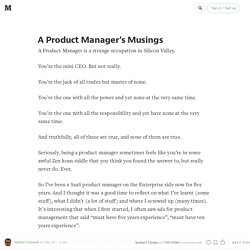
You’re the mini CEO. But not really. You’re the jack of all trades but master of none. You’re the one with all the power and yet none at the very same time. You’re the one with all the responsibility and yet have none at the very same time. And truthfully, all of these are true, and none of them are true. Seriously, being a product manager sometimes feels like you’re in some awful Zen koan riddle that you think you found the answer to, but really never do.
Tie Your Ego to the Product, Not the Process. I was beginning to design my first big feature at Etsy a few months ago and had a kick-off meeting with Andrew, the engineer who would be building it out with me.
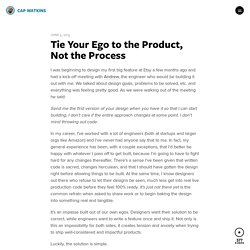
We talked about design goals, problems to be solved, etc. and everything was feeling pretty good. As we were walking out of the meeting he said: Send me the first version of your design when you have it so that I can start building. I don’t care if the entire approach changes at some point. How to nail your product market fit and sales pitch with a value proposition diagram. Products aren’t sold in isolation - they exist within ecosystems.

Great product market fit and sales pitches hinge on understanding and serving all the members of an ecosystem. Should a product fail to meet the needs of any one member, company success and sales velocity will falter. One tool I use with portfolio companies is the Value Proposition Diagram (VPD) which shows why a product is compelling to every customer - and most products are sold to more than one customer at the same time. I’ll walk through three examples of the VPD: Google AdSense, Expensify and Axial Market. A VPD has three columns: the product, the customers and the value proposition for each customer. Google’s AdSense enables publishers to run ads on their websites to generate revenue.
The user is the most important. The advertiser follows the user in importance. That’s the genius of AdSense: ad relevancy aligns the incentives of everyone in the ecosystem. Product Strategy Means Saying No. If you’re building a product, you have to be great at saying No.

Not ‘maybe’ or ‘later’. The only word is No. Rarely say yes to feature requests - Inside Intercom. Here’s a simple set of Yes/No questions that you can quickly answer before you add another item to your product roadmap.
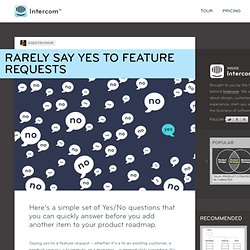
Saying yes to a feature request – whether it’s a to an existing customer, a product enquiry, a teammate, or a manager – is immediately rewarding. It’s an unspoken transaction where you barter long term product focus in exchange for short term satisfaction. Buying short term joy for the cost of long term pain is the human condition. The Startup Product Manager’s Toolkit — Product Management. I’m part of a small group of startup PMs that meets up every 1-2 months to share, debate, encourage, rant, laugh, cry; and one direction our conversation often steers is the tools that startup PM’s should use to optimize their jobs and their organizations’ product development processes (in the absence of big company internal resources and pre-existing processes).

While there are tons of helpful tools available on the market (Asana/Jira/Trello, Optimizely, Mixpanel, etc), there’s also a lot of Google-doc, wiki, excel, ppt, and internal tools going on. The world's #1 product roadmap software. Blossom - Agile Project Management. Agile Project Management. Trello.
Create Beautiful Roadmaps Quickly. What Does Feature Creep Look Like? When you think about feature creep and bloated products what comes to mind?

Endless tabs, toolbars, settings, and preferences, right? For a 5 year period you couldn’t sit through a UX talk without seeing some variation of this infamous Microsoft Word screenshot as example of the need for simplicity… Poor UI such as that above highlights the cost of feature creep. There is simply too much stuff for users to comprehend. The problem is that horrible screens like this don’t inform you about what to do next. To solve feature creep you need to identify which features are being adopted by everyone, and which ones are struggling to gain traction. Analyse Adoption per feature The X axis is each feature in your product and the Y axis is the percentage of customers1 who are using2 the feature3. Customers: Which customers? Intercom on Product Management book. Designing products for single and multiplayer modes. The first million people who bought VCRs bought them before there were any movies available to watch on them.

They just wanted to “time shift” TV shows – what we use DVRs for today. Once there were millions of VCR owners it became worthwhile for Hollywood to start selling and renting movies to watch on them. Eventually watching rented movies became the dominant use of VCRs, and time shifting a relatively niche use. Thus, a product that eventually had very strong network effects* got its initial traction from a “standalone use” – where no other VCR owners or complementary products needed to exist. I was talking to my friend Zach Klein recently who referred to products as having single player and multiplayer modes. Many products that we think of as strictly multiplayer also have single player modes. . * Products with so-called networks effects get more valuable when more people use them. What Drives Consumer Adoption Of New Technologies? I'm participating in a panel discussion this morning during the offsite of a major media company.
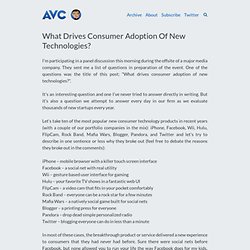
They sent me a list of questions in preparation of the event. One of the questions was the title of this post; "What drives consumer adoption of new technologies? ". It's an interesting question and one I've never tried to answer directly in writing. But it's also a question we attempt to answer every day in our firm as we evaluate thousands of new startups every year. Let's take ten of the most popular new consumer technology products in recent years (with a couple of our portfolio companies in the mix): iPhone, Facebook, Wii, Hulu, FlipCam, Rock Band, Mafia Wars, Blogger, Pandora, and Twitter and let's try to describe in one sentence or less why they broke out (feel free to debate the reasons they broke out in the comments): Screw the Power Users. I designed HomeSite and TopStyle for power users. Only power users would want to edit HTML & CSS by hand, so I made sure to cater to them.
Those products were filled with features and tool buttons, and their settings dialogs contained dozens of geeky options. Customers liked them that way. I liked them that way, too. But then I made FeedDemon. At first I built FeedDemon as though my customers were geeks like me, since that was what I was used to. So with each new version I tried to simplify the user interface, and dropped features & options that complicated the product. Criticism and Two Way Streets. A post by Jason Fried titled “Give it 5 minutes” reminded me of a great technique I learned about from Bill Buxton.
Bill is a Principal Researcher in Microsoft where his main role focuses on designing a company that permits great design to happen. As many have learned to their peril, it’s not simply a case of just dumping talent in a room full of Ikea furniture. In large companies you have to design the process that creates design. One key idea Bill advocates is an emphasis on exploring the solution space before iterating on a solution. However having great designers each producing great solutions to a shared problem can cause conflict, if not managed correctly… Exploring the Solution Space Like Apple, Microsoft encourages their designers to create many different solutions to any given design problem.
When Does Your Solution Suck? Every solution is great in some circumstances and terrible in others. Less Time Arguing, More Time Designing.